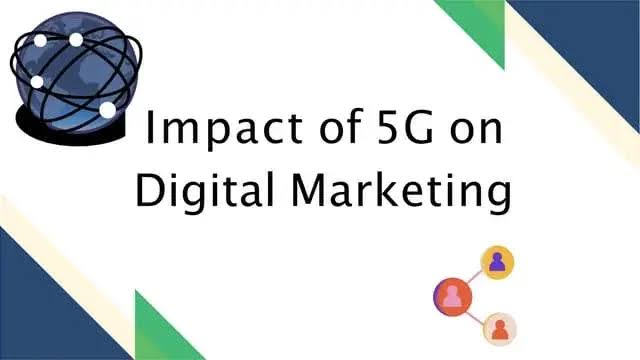The rollout of 5G has introduced a new era of digital marketing, defined by speed, interactivity, and personalization. From immersive AR campaigns to seamless e-commerce experiences, 5G empowers marketers to engage audiences in ways that were once impossible. While challenges related to privacy and access remain, the benefits of 5G for digital marketing far outweigh the limitations.
The arrival of 5G technology is transforming how people connect, communicate, and consume digital content. With its ultra-fast speeds, minimal latency, and ability to connect millions of devices simultaneously, 5G is reshaping industries far beyond telecommunications. For digital marketing in particular, 5G is opening new opportunities for brands to engage with consumers in innovative and immersive ways. As of 2025, businesses that understand the impact of 5G on consumer behavior and digital advertising strategies are already gaining a competitive edge.
Revolutionizing mobile user experiences
Mobile devices have become the primary channel for digital marketing, and 5G amplifies their potential by delivering faster and more reliable connections. Consumers can now stream high-quality video without buffering, interact with content in real time, and engage with data-heavy applications seamlessly.
For marketers, this translates into the ability to deliver richer campaigns without worrying about lag or slow loading times. Websites and landing pages optimized for 5G can feature interactive elements such as high-resolution graphics, live chatbots, and immersive product demos without frustrating users with delays. This level of responsiveness enhances brand perception and boosts customer engagement.
Enabling immersive technologies
One of the most significant contributions of 5G to digital marketing is its ability to support technologies such as augmented reality (AR), virtual reality (VR), and mixed reality (MR). These immersive experiences require massive amounts of data and extremely low latency, both of which are made possible by 5G.
Brands can now create interactive AR filters for social media, virtual try-on tools for e-commerce, and VR experiences for product demonstrations or virtual showrooms. For example, a fashion brand can allow customers to try clothing virtually before purchasing, while real estate companies can offer virtual property tours. These immersive tools not only increase consumer confidence but also create memorable experiences that strengthen brand loyalty.
Boosting video marketing
Video continues to dominate digital marketing, and with 5G, the possibilities expand even further. Consumers can now watch 4K and even 8K videos on mobile devices without lag, making high-definition storytelling more accessible. Live streaming has also benefited, with 5G enabling smoother, real-time broadcasts across platforms such as YouTube, Instagram, and TikTok.
Marketers can capitalize on this by hosting live product launches, Q\&A sessions, or behind-the-scenes events, knowing that the audience will enjoy uninterrupted viewing. The combination of high-quality visuals and interactive features creates stronger emotional connections and drives higher engagement rates.
Personalization through real-time data
5G enhances data collection and processing, allowing marketers to deliver highly personalized content in real time. By analyzing user behavior, location, and preferences with greater speed, brands can serve dynamic ads tailored to individual consumers instantly.
For example, location-based marketing powered by 5G can provide hyper-localized offers. A coffee shop could send a promotional notification to a user passing nearby, or a retail store could target shoppers in a mall with customized discounts. This level of personalization not only improves conversion rates but also enhances the customer experience by delivering relevant and timely messages.
Expanding the role of IoT in marketing
The Internet of Things (IoT) is closely tied to 5G, as the network’s speed and device capacity make it possible to connect billions of devices efficiently. For digital marketing, IoT opens new touchpoints to reach consumers through connected cars, smart home devices, wearables, and even appliances.
Marketers can create campaigns that integrate seamlessly into daily life. A fitness brand might deliver personalized workout recommendations through a wearable device, or an automobile company could send service reminders through a connected car system. These subtle yet consistent interactions help build stronger relationships between brands and consumers.
Driving e-commerce innovation
E-commerce has been one of the biggest beneficiaries of 5G. Faster load times, immersive product views, and smoother checkout processes are improving the online shopping experience. Consumers can browse interactive catalogs, engage with 3D product visualizations, and use AR tools to preview items in their own environment before purchase.
Additionally, the integration of AI with 5G networks enhances chatbots and virtual assistants, making them more responsive and human-like. This allows e-commerce platforms to provide real-time customer support, streamline transactions, and deliver tailored product recommendations, all of which increase sales and customer satisfaction.
Empowering programmatic and real-time advertising
The speed of 5G significantly impacts programmatic advertising, where ads are bought and placed automatically based on data insights. With faster networks, real-time bidding (RTB) becomes even more efficient, ensuring that the right ads reach the right audiences at the right moment.
Marketers can also experiment with dynamic ad formats, including interactive video and AR-based ads, which would have been difficult to deliver effectively over slower networks. This evolution ensures that digital advertising is not only faster but also more engaging and relevant to consumers.
Challenges and considerations
Despite its benefits, the rise of 5G in digital marketing also presents challenges. Privacy concerns are heightened as more data is collected in real time. Consumers are becoming more cautious about how their information is used, prompting stricter regulations and demanding greater transparency from brands.
Additionally, while urban areas may already enjoy widespread 5G coverage, rural and underserved regions still face connectivity gaps. Marketers must consider inclusivity to ensure campaigns do not alienate audiences with limited access to advanced networks.
Future outlook
Looking ahead, the impact of 5G on digital marketing will continue to grow as adoption becomes more widespread. The integration of AI, AR, VR, and IoT with 5G will create unprecedented opportunities for creativity and engagement. Brands that invest early in experimenting with these technologies will be well-positioned to capture consumer attention in increasingly competitive markets.
